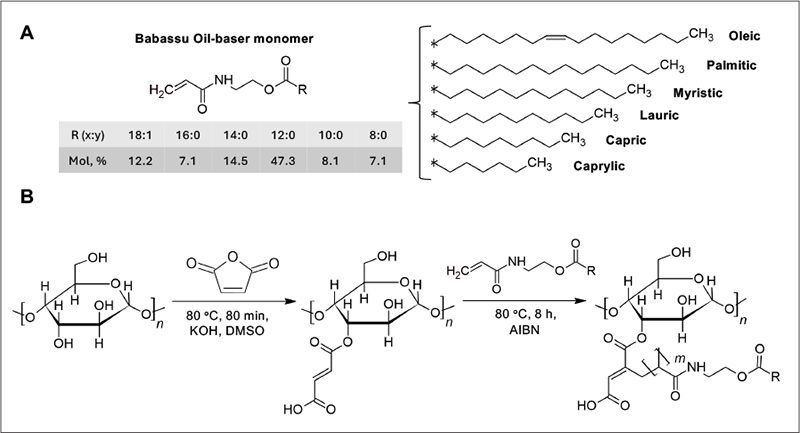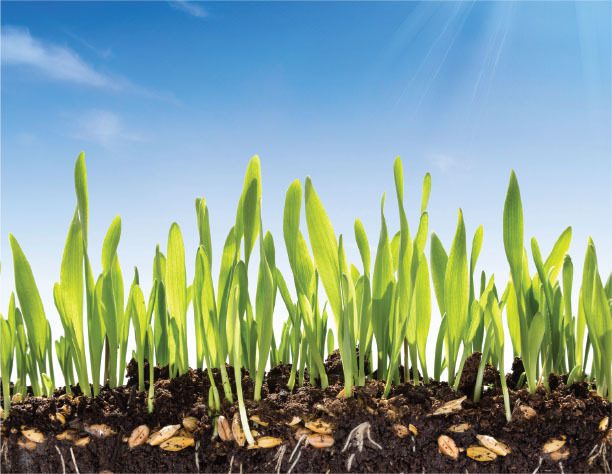Student Spotlight: Discoveries from university researchers
By Kateryna Rudich, Yehor Polunin, Ayda Dadras, Mohiuddin Quadir, and Andriy Voronov
Introduction
The use of polymers as a seed coating is a prevalent agricultural practice because it helps to reduce the overall amount of chemicals needed, promoting more sustainable farming practices. Seed coating is the process of applying a protective layer, typically made of polymers, nutrients, or agrochemicals, to seeds before planting. The primary purposes of seed coatings are to enhance seed performance, protect against pathogens and pests, improve germination rates, and provide essential nutrients during early plant development, all while minimizing the risks associated with conventional seed treatment methods.1 However, seed coatings mainly involve the use of petroleum-based, non-biodegradable polymers that significantly contribute to microplastic pollution.
This study explores the potential of biomass- and plant oil-based polymers recently developed by our group as a sustainable alternative to be applied in seed coatings. The resulting polymer, consisting of hemicellulose xylan modified by grafted chains made of babassu oil-based monomers (HX-g-BOBM), is designed as a sustainable film-forming material targeting advanced water barrier performance.2 HX-g-BOBM is a highly biobased, tough, and processable bioplastic. Being biodegradable, it may offer a renewable alternative to applications of conventional petroleum-based polymers in food packaging. This study evaluates the feasibility of HX-g-BOBM as a seed coating by applying it to corn (Zea mays) seeds and assessing the effect on the seeds’ vigor and viability.
HX-g-BOBM Synthesis
Agricultural wastes such as some lignocellulosic materials and plant oils are excellent renewable resources for the production of sustainable coatings due to their chemical versatility, availability, and often low cost.3-6 HX-g-BOBM is synthesized from hemicellulose xylan and babassu oil, which are believed to be inherently biodegradable or compostable by nature. Babassu oil-based monomer (BOBM) and HX-g-BOBM were synthesized following the procedures described in earlier publications.1,7,8 The structure of BBM is shown in Figure 1A. A schematic representation of HX-g-BOBM synthesis is presented in Figure 1B. Before polymerization, xylan was reacted with maleic anhydride through an esterification reaction. During this process, an ester bond is formed between the maleic anhydride and hydroxyl groups of xylan, while the vinyl group of maleic anhydride remains intact, providing a reactive site for the attachment of BOBM-based grafted chains. After successful maleinization, the modified xylan was added to the BOBM along with the AIBN initiator (1.5 wt %). Grafting polymerization reaction was conducted in bulk at 80 °C for 8 hours under a nitrogen atmosphere. After purification from unreacted xylan and BOBM, a homogeneous solution of highly branched HX-g-BOBM was obtained. Multiple xylan macromolecules are decorated by BOBM chains, and BOBM homopolymer is also present in the resulting material.
FIGURE 1 The chemical structure of babassu oil-based monomer (BOBM) used in this study. R (x:y) – the structure of the fatty acids (x – the number of carbon atoms in the fatty acid chain, y – the number of double bonds in the fatty acid) (A). Synthetic scheme of HX-g-BOBM grafted polymerization (B).

HX-g-BOBM Emulsification
To simulate an industrial approach, where seeds are typically covered by spraying a water-based slurry containing polymers and additives over the seeds in a rotating drum machine, HX-g-BOBM was emulsified in water. Dodecylbenzenesulfonic acid, which serves as an emulsifying agent, was first dissolved in water, vortexed for 5 min, and ultrasonicated for 20 min. The HX-g-BOBM dispersion was then added dropwise and was vortexed for an additional 5 min and ultrasonicated for 20 min until a stable emulsion with a final polymer content of 15 wt % was achieved. Particle size measurement was conducted using a Malvern Zetasizer Nano-ZS90 (Figure 2A).
The viscosity of the emulsion was measured using an ARES G2 rheometer with 25 mm parallel plate clamps, gap size 0.5 mm, strain 1%, frequency range 1-500 rad/s, and temperature 25 ºC. The viscosity of the HX-g-BOBM emulsion exhibits non-Newtonian behavior, with apparent viscosity decreasing as the shear rate increases, indicating shear-thinning behavior. At low shear rates (< 1 rad/s), the emulsion displays high viscosity, suggesting good stability and minimal settling of particles. The apparent viscosity decreased significantly at higher shear rates (> 10 rad/s), indicating that the emulsion would flow more easily during the seed coating process, which is beneficial for uniform coating application in industrial applications (Figure 2B).
FIGURE 2 Particle size (A) and rheological behavior (B) of 15 wt % HX-g-BOBM water emulsion.

Seed Coating Procedure
Seeds were coated manually using a plastic bag with a subsequent transfer of seeds to the sieve and drying at room temperature (25 ±1°C) for 24 hours. In each case, 100 corn seeds were incubated with 2 ml of water-based polymer slurry and manually shaken for 5 minutes to simulate the industrial rotating drum coating procedure. The weight of the seeds was compared before and after the coating procedure. The average weight increase was found to be 2.0 ± 0.3 wt % from the initial mass of seeds.
HX-g-BOBM Coating Water Absorption
The water absorption test was conducted to evaluate the coating’s interactions with water. Coating film samples were submerged in 20 ml of distilled water and kept at room temperature. After immersion, excess water was removed, and the samples were weighed at specific time intervals to quantify the changes in mass. To ensure accuracy and reliability, each test was performed in triplicate. The resulting plot shows the relationship between time and weight gain (Figure 3A). The ability of the coating to swell is advantageous for enhancing water retention, by helping to keep the seeds hydrated after planting.
Continue reading in the November-December digital issue of CoatingsTech
